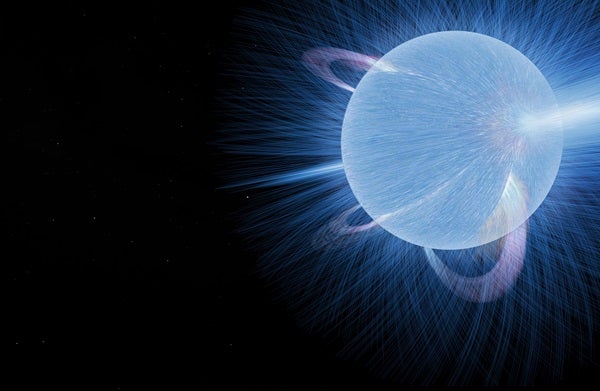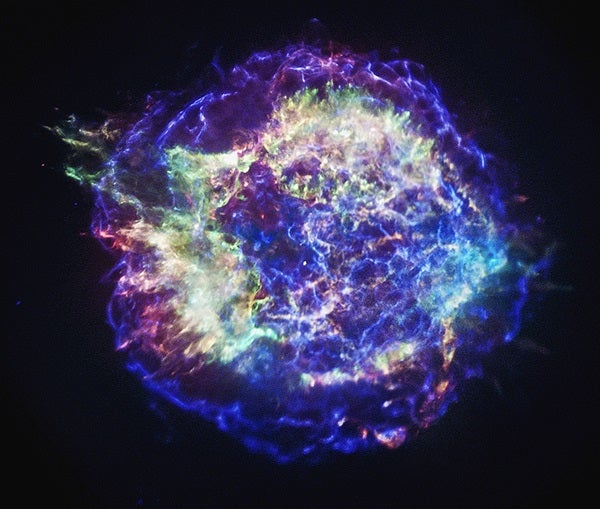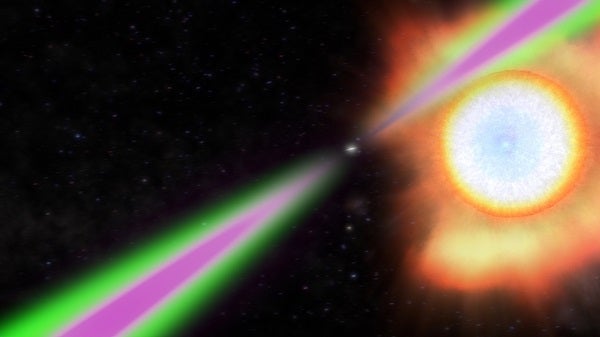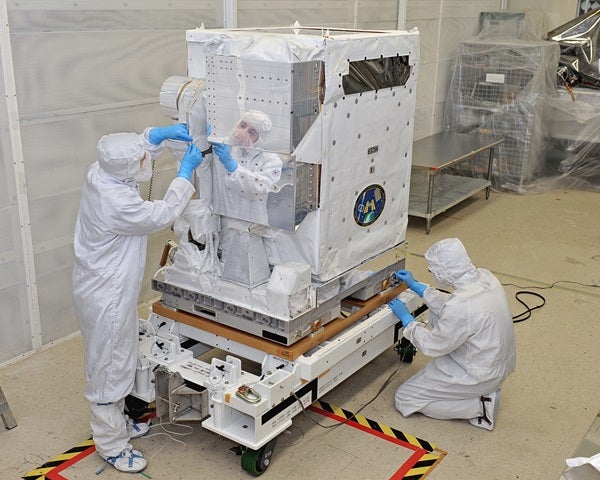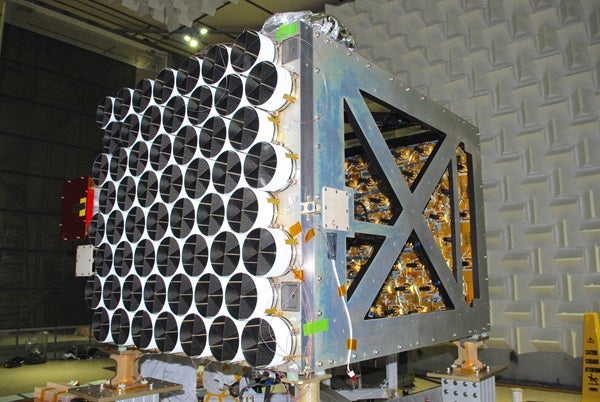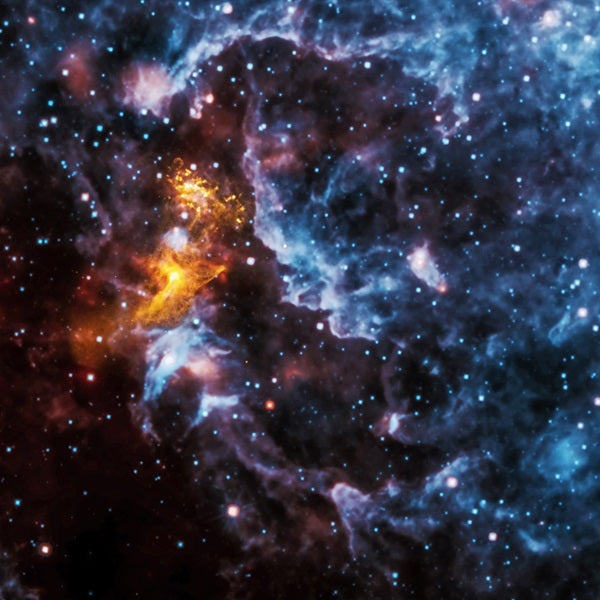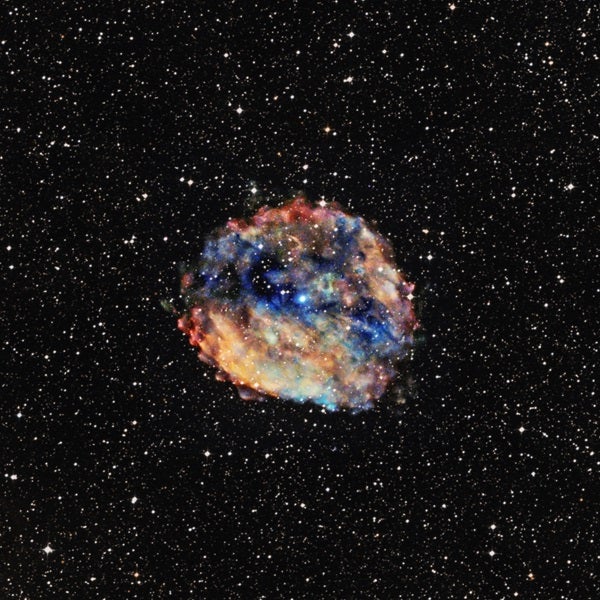Neutron stars pack a mass equivalent to half a million Earths into a sphere about 12 miles (20 kilometers) across — less than the length of Manhattan Island in New York City — and typically rotate hundreds to thousands of times per minute. Their large masses and small sizes result in gravitational fields at their surfaces more than 100 billion times stronger than Earth’s, enough to substantially warp space-time and allow precise tests of Albert Einstein’s theory of general relativity.
Neutron star matter, crushed to densities greater than that of an atomic nucleus, is so compressed that a thimbleful would hold twice the mass of all 7.4 billion people alive on Earth. And their cores, with hundreds of millions of tons squeezed into each cubic centimeter, are so compact that scientists don’t really understand what state of matter prevails there. “We don’t know if it is a sea of quarks, or a soup of neutrons with other exotic particles,” says Paulo Freire at the Max Planck Institute for Radio Astronomy in Bonn, Germany. “It is certainly not atomic matter as we know it here on Earth.”
In principle, spinning neutron stars could provide clues to internal structure because at some speed, they must simply fly apart. Some models predict a breakup near 2,000 rotations per second, while others indicate disruption at around 1,200. PSR J1748–2446ad holds the record for fastest known spin, at 716 times per second, but this is too slow to distinguish between current neutron star models.
What’s missing is a better knowledge of the masses and sizes of neutron stars, astronomers say. NASA designed the Neutron star Interior Composition Explorer (NICER) to address this gap. The observatory, which launched in June, is mounted on the skyward side of the International Space Station. Among the mission’s top science goals is to measure the radii of at least three neutron stars to an unprecedented accuracy of 5 percent.
“That 5 percent level comes from the nuclear physics experts who tell us that if we can do this three or four times for different stars, they can turn that into firm constraints on the particles making up the interior,” says Zaven Arzoumanian, deputy principal investigator for NICER at NASA’s Goddard Space Flight Center in Greenbelt, Maryland. “We should be able to eliminate whole families of equations of state.”
James Chadwick of the Cavendish Laboratory at the University of Cambridge unwittingly opened the door for studying neutron stars in 1932 when he discovered the neutron, a particle in atomic nuclei that has no electric charge. Just two years later, long before scientists knew many details about stellar explosions, Fritz Zwicky and Walter Baade at Mount Wilson Observatory in California began referring to the most exceptional stellar outbursts as “super-novae” and made a convincing and prescient case that these events represent the collapse of an ordinary star into a neutron star.
The more mass a star begins life with, the brighter it shines and the faster it runs through its fuel supply. Nuclear fusion transforms hydrogen into helium, producing energy in the form of gamma rays and neutrinos, which are ghostly particles that travel at nearly the speed of light and rarely interact with matter. Once these reactions deplete the hydrogen, the star’s core contracts and heats until the accumulated helium “waste” ignites, generating energy by fusing helium nuclei into carbon and oxygen.
For stars born with less than about 8 solar masses, the recycling program typically ends there. For most of these stars, the core contracts and heats up again but never reaches temperatures high enough to fuse carbon. At the high end of this mass range, however, stars proceed to fuse carbon and produce cores of oxygen, neon, and magnesium. Either way, they reach a point where further collapse stops and temperatures don’t climb high enough to make use of the remaining fuel.
As the core collapses into smaller volumes, electrons are forced to occupy higher energy states and to move faster. Because of a quirk of quantum mechanics known as the Pauli exclusion principle, no two electrons can share the same energy state, so the fastest electrons can’t slow down. This so-called electron degeneracy results in a countervailing pressure that supports the star. As long as the core weighs less than about 1.4 solar masses, the collapse ceases, and it becomes a white dwarf.
When the core’s temperature reaches 18 billion degrees Fahrenheit (10 billion kelvins), gamma rays begin to split iron nuclei. Instead of adding energy to the core, this process takes it away, breaking iron into helium nuclei and neutrons. The helium quickly absorbs gamma rays and dissociates into protons and neutrons. By the time electron degeneracy starts to flex its muscle, the electrons are disappearing, merging with protons to produce neutrons and neutrinos. The neutrinos escape easily, another process that saps support from the doomed stellar core, and the numbers of electrons and protons each drop to about 10 percent of the number of neutrons.
As the collapse proceeds and the core temperature becomes a hundred times hotter, neutrons begin exerting their own degeneracy pressure. The core stiffens, halting the collapse and sending a powerful outward-moving shock wave through stellar layers continuing to rain down on the nascent neutron star. The shock briefly stalls, but astronomers think the flood of neutrinos pouring from the core re-energizes it. The shock then moves outward again, destroying the star’s outer layers in a supernova explosion and leaving behind a neutron star.
In 1939, J. Robert Oppenheimer and George Volkoff, both at the University of California, Berkeley, showed that neutron degeneracy alone cannot halt the collapse of a core weighing more than 70 percent of the Sun’s mass. Later studies factored in the pressure produced by strong repulsive nuclear forces, bringing the theoretical maximum to about 3 solar masses. Beyond this limit — reached by stars born with more than 20 solar masses — core collapse cannot be stopped, and the remnant becomes a black hole.
Although Zwicky and Baade predicted neutron stars in 1934, astronomers didn’t detect one until 1967. That’s when Antony Hewish and Jocelyn Bell Burnell, working at the Mullard Radio Astronomy Observatory near Cambridge, England, discovered the precisely timed radio emissions these stellar remnants produce. The first scientific publications referred to these objects as “pulsating radio sources,” which Anthony Michaelis, science correspondent for The Daily Telegraph in the U.K., shortened to “pulsar.” The name stuck, and astronomers have cataloged more than 2,600 radio pulsars in our galaxy since. Many of them now have been detected in X-rays and gamma rays as well.
Nearly all known neutron stars have detectable pulsations at some wavelength because they rotate rapidly and possess hot spots at their magnetic poles. So, for the most part, the terms pulsar and neutron star can be regarded as synonyms. The quietest ones, called central compact objects, appear near the centers of young supernova remnants and radiate only low-energy X-rays. “They’re weak, thermal X-ray sources — hot neutron stars — and that’s all we see,” says Goddard astrophysicist Alice Harding. Astronomers have seen X-ray pulsations with periods of a few tenths of a second in a few members of this class. The emissions indicate the objects have surprisingly weak magnetic fields incapable of producing the activity seen in other types of neutron stars.
“The magnetic field is everything for a neutron star, probably determining all of its behavior,” says Harding. So why do some baby neutron stars possess such paltry fields? One possibility is that their normal fields get “buried” when a small amount of stellar material falls back onto the neutron stars within hours of their births. A 2015 study led by Alejandro Torres-Forné at the University of València, Spain, found that a modest amount of material — less than 10 times the mass of Jupiter — may be enough to force a typical trillion-gauss pulsar magnetic field beneath the surface. This is only temporary, however, and the field will re-emerge a few thousand years later. It suggests weak fields may be somewhat common in newly minted neutron stars.
Isolated neutron stars form another distinct class, one with only seven confirmed members. Sometimes called The Magnificent Seven, these objects are less than 1,600 light-years away, lack any associated supernova remnant or pulsar-produced nebula, and emit only low-energy X-rays with weak pulses ranging from 3 to 11 seconds. They appear to be middle-aged, cooling neutron stars with stronger-than-average magnetic fields. If the fields decayed from much higher values, these objects could be old versions of magnetars, which sport the strongest fields of the neutron star family. More on them later.
Researchers are still working out the details of how and where the emissions at different wavelengths occur, but NASA’s Fermi Gamma-ray Space Telescope has helped clarify the picture. “We have a much better idea after Fermi because we know that the very high-energy gamma rays are coming from the outer parts of the magnetosphere,” says Harding. Typically, gamma-ray pulses lag well behind the radio pulses, which means they must be produced some 10 times farther away from the pulsar.
Timing the radio pulses of neutron stars is an astonishingly precise business. “Almost everything we measure in pulsar timing is determined to an accuracy that is completely unheard of anywhere else in astronomy,” says Freire. “In some cases, we can measure the spin period of pulsars to 15 decimal places.” If we could measure the Moon’s distance this precisely, we would know its position to within 0.4 micrometer, about one-fifth the thickness of a human red blood cell.
The speed demons
Some rotation-powered pulsars have downright ridiculous spins, exceeding 100 times per second. Most of these so-called millisecond pulsars reside in binary systems. Astronomers think they were born with more typical periods and were slowing gradually over tens of millions of years. But eventually their companions evolved and enlarged to the point where a steady stream of gas fell onto the neutron stars, revving them up to the crazy periods we see today. For this reason, astronomers often refer to them as “recycled” pulsars.
In some close systems, emission from the reinvigorated pulsar blasts the companion, heating its atmosphere and slowly whittling it away. Eventually, only the neutron star will remain, helping explain why roughly 20 percent of recycled pulsars have no stellar partner. Depending on the current mass of the companion star, astronomers classify these systems as black widows or redbacks, named after spiders that can turn on their mates.
These exotic objects particularly interest Roger Romani, an astrophysicist at Stanford University. “I want to know how the companion evaporation is driven, what component of the pulsar wind does the work,” he says. The evolution that creates a black widow may make the neutron star especially massive, so Romani has been measuring and modeling black widow companions to infer the pulsar mass. A sufficiently heavy pulsar would help lock down the dense-matter equation of state.
Millisecond pulsars are the most stable clocks in the neutron star family. This makes them useful tools in the search for gravitational waves, the ripples in space-time produced by merging black holes and other events that constantly jostle Earth. By monitoring the spins of dozens of pulsars distributed around the sky, astronomers effectively have created a galaxy-sized detector to find these signals and measure how the waves stretch and squeeze our planet.
X-ray binaries
Accreting neutron stars might be the most social class of these objects because they are actively accumulating matter from binary companions. In low-mass X-ray binaries, the compact object is either a neutron star or a black hole, and the donor star is either a white dwarf, a red giant, or a Sun-like star. Neutron stars in these systems are old and have magnetic fields 10,000 times weaker than typical radio pulsars.
In some of these systems, neutron stars erupt in sudden bursts of X-rays that repeat after some time. Hydrogen flows onto the neutron star and immediately fuses, producing a growing layer of helium that covers the entire surface. Eventually, the helium layer undergoes explosive fusion that produces a bright burst of X-rays, and the process repeats.
High-mass X-ray binaries pair a neutron star or a black hole with a hot O or B type star holding 10 or more times the Sun’s mass. The massive star’s immense luminosity drives a continuous outflow of gas that the compact object sweeps up. These binaries have X-ray pulsation periods that range from one to hundreds of seconds and magnetic fields with strengths typical of radio pulsars.
Because massive stars must eventually collapse and become supernovae, many of these systems will evolve into binaries containing a pair of neutron stars. In 1974, Russell Hulse and Joseph Taylor Jr. at the University of Massachusetts, Amherst, discovered the radio pulsar B1913+16, which spins nearly 17 times per second. After monitoring it for a while, they noticed periodic changes indicating the pulsar has a companion: another neutron star, though this one has no detectable pulsations. After following the system for a few years, Hulse and Taylor showed in 1978 that the orbits are shrinking in accordance with Einstein’s prediction that the stars must lose orbital energy by emitting gravitational waves.
Astronomers have now measured orbital decays for many other double neutron stars as well as for a few millisecond pulsar-white dwarf binaries. One of these systems really stands out. PSR J0737−3039 is the most compact double neutron star binary known, with an orbital period of just 2.45 hours. And both are also pulsars, making this the only known double pulsar and a unique laboratory for studying gravitational physics.
Magnetic monsters
Magnetars make up the final branch of the family tree. Of the 2,600 neutron stars known, only 29 belong to this group. Their magnetic fields are the strongest in the cosmos, 100 to 1,000 times stronger than those found in typical rotation-powered pulsars. They come in two varieties — soft gamma-ray repeaters (SGRs) and anomalous X-ray pulsars — that scientists originally thought were unrelated. They have spin periods between 2 and 12 seconds and undergo episodes of repeated X-ray and gamma-ray bursts lasting a few tenths of a second. Each burst emits an energy equivalent of up to 10 million Suns, and these episodes may recur years later.
More amazingly, magnetars can produce giant flares up to a million times more powerful still. The energy for this activity must come from superstrong magnetic fields so powerful that they apply higher stresses to the star’s crust. This could lead to burst-triggering “star quakes” that fracture the crust. Or the magnetic field may become twisted, storing energy until it reconfigures to a different state and suddenly releases it. In all likelihood, both mechanisms are involved.
Some recent discoveries now suggest magnetars may be closer to their rotation-powered cousins than originally thought. In 2009, Fermi observed magnetar-like bursts from a source named SGR 0418+5729, but X-ray studies show its magnetic field is no stronger than a typical pulsar’s. In 2011, NASA’s Swift observatory detected short X-ray bursts from SGR 1822–1606, but its magnetic field is almost as weak. Then, in July 2016, Fermi and Swift observed a dozen magnetar-like bursts from PSR J1119−6127, a source that previously behaved like a typical radio and gamma-ray pulsar despite its unusually strong magnetic field. “So now we’re asking what’s the difference between radio pulsars and magnetars,” Harding says. “The field structures may be fundamentally different, but we still don’t know whether that’s the answer.”
The high-energy radiation surrounding a typical neutron star would not make it an inviting vacation destination. But what would we find if we could protect ourselves from the hazards and travel into a neutron star? Our destination will be an isolated, 1.4-solar-mass, 12-mile-wide (20 km) pulsar just a few hundred years old. First, we traverse a hot ionized atmosphere just a few inches (10 centimeters) thick, possibly made of hydrogen, helium, or carbon. Next, we reach a 4 million F (2.2 million K) surface — a thin ocean populated by free electrons and the nuclei of iron-56 and lighter elements.
After the first couple of yards of our descent, we reach the outer crust. As we go deeper, iron gives way to nuclei packed with more and more neutrons. Experiments at the European Organization for Nuclear Research near Geneva show that the next elements will be nickel-62 — the most tightly bound nucleus — followed by other nickel isotopes and then krypton-86. At a depth of about 110 yards (100 meters), the nuclei become organized into a regular crystalline structure immersed in a degenerate electron gas.
Just before we hit the quarter-mile (400 m) mark, where the density is so high a thimbleful of matter would weigh 925,000 tons, we reach the inner crust. At this point, most neutrons leak out of nuclei and likely form a superfluid, a substance that keeps flowing with no loss of energy, plus protons and degenerate electrons. Nuclei condense into large spherical collections immersed in the neutron fluid like meatballs in sauce. Physicists suspect these spheres are crushed into unusual shapes over the next half-mile (800 m) or so, first rods resembling spaghetti and then plates resembling lasagna. Not surprisingly, scientists refer to this state as nuclear pasta. At greater depth, the shapes get crushed into uniform nuclear matter much like the outer core. Holes form, filled with neutron superfluid, and shrink in size the deeper we go.
At a depth of about 0.7 mile (1.1 km), we reach the outer core. It’s filled with neutron superfluid, degenerate electrons, protons in a superconducting state — where electrical currents flow indefinitely with no resistance — and muons, a heavyweight relative of electrons. In traditional neutron star models, this composition would extend all the way to the center, making up the entire core. But if the density rises above that of an atomic nucleus, where a thimble-sized volume weighs 900 million tons, an inner core will form about 3 miles (5 km) down.
As mapmakers of old once warned, here be dragons. The inner core may contain many types of exotic matter. They include hyperons, which are particles more massive than protons that contain at least one strange quark, condensed matter made of strange mesons, or quarks completely freed from the confines of the nuclear particles they construct.
No one knows. But new astronomical data may soon provide nuclear physicists with the constraints they need to begin narrowing down these possibilities. In the meantime, neutron stars will continue their pulsing, accreting, bursting, and flaring behaviors to the unending fascination of astrophysicists.

